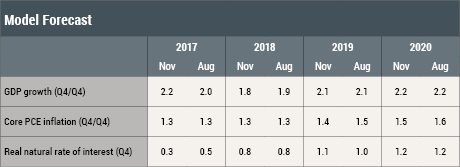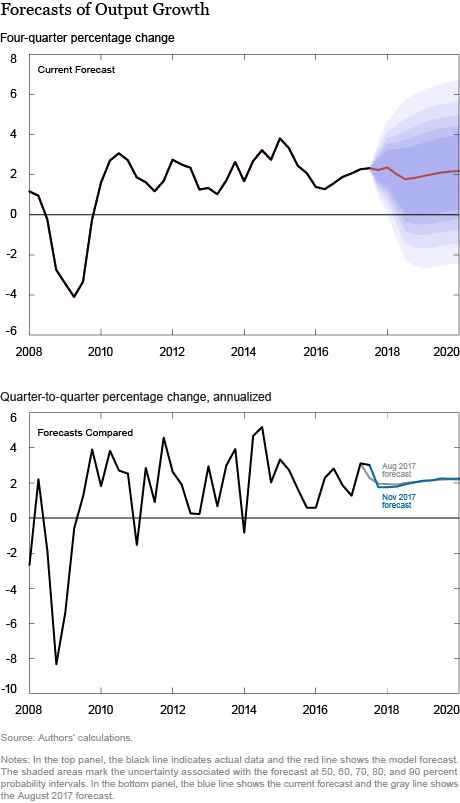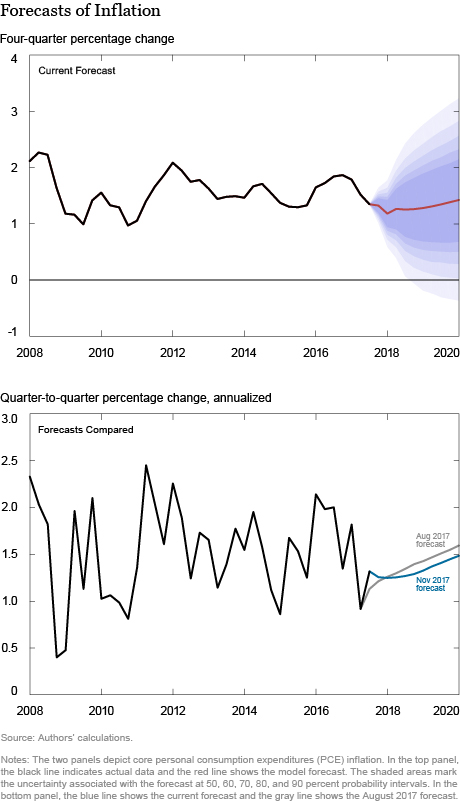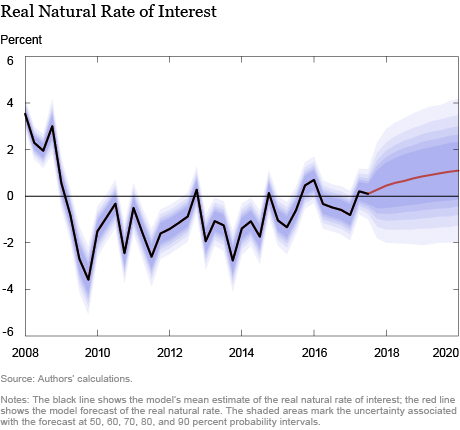This post presents our quarterly update of the economic forecast generated by the Federal Reserve Bank of New York’s dynamic stochastic general equilibrium (DSGE) model. We describe very briefly our forecast and its change since August 2017.
As usual, we wish to remind our readers that the DSGE model forecast is not an official New York Fed forecast, but only an input to the Research staff’s overall forecasting process. For more information about the model and variables discussed here, see our DSGE model Q & A.
The November model forecast for 2017–20 is summarized in the table below, alongside the August forecast, and in the charts that follow. The model uses quarterly macroeconomic data released through the third quarter of 2017 and available financial data through November 1, 2017.




How do the latest forecasts compare with the August forecasts?
- The current Q4/Q4 GDP growth forecast for 2017 is slightly higher than in August. According to the first GDP print, growth in the third quarter was slightly stronger than predicted by the model in August, pushing the 2017 output growth projection to 2.2 percent. GDP growth is expected to moderate to 1.8 percent next year before accelerating again to about 2.2 percent in the following years, in line with the August forecast.
- Low credit spreads between Baa corporate and Treasury securities, which have narrowed further since August, continue to provide stimulus to growth by maintaining favorable financial conditions. However, the model still forecasts only a modest pickup in growth over the medium and longer term because productivity growth is projected to remain subdued.
- Inflation is currently slightly above the level that was forecast in August, but it is projected to decline in the short run and to reach only 1.5 percent by 2020. The model attributes the temporarily higher inflation in 2017 (in Q/Q terms) to a smaller drag from price and wage markup shocks than had been predicted in August. Nevertheless, the overall profile of the inflation forecast remains extremely subdued, as in August.
- The model’s estimate of the real natural rate of interest—the real rate of interest that would prevail in the economy absent nominal rigidities and markup shocks—is slightly lower for 2017 relative to the August estimate. This revision is mainly due to the model’s assessment of lower productivity growth going forward, which translates into a lower natural rate today. This negative force is partly counteracted by lower credit spreads. The natural rate is projected to increase gradually throughout the forecast horizon, rising only slightly above 1 percent toward the end of 2019. This assessment is unchanged relative to August.
Disclaimer
The views expressed in this post are those of the authors and do not necessarily reflect the position of the Federal Reserve Bank of New York or the Federal Reserve System. Any errors or omissions are the responsibility of the authors.

Ozge Akinci is an economist in the Federal Reserve Bank of New York’s Research and Statistics Group.

Michael Cai is a senior research analyst in the Bank’s Research and Statistics Group.

Abhi Gupta is a senior research analyst in the Bank’s Research and Statistics Group.

Pearl Li is a senior research analyst in the Bank’s Research and Statistics Group.

Andrea Tambalotti is an assistant vice president in the Bank’s Research and Statistics Group.
How to cite this blog post:
Ozge Akinci, Michael Cai, Abhi Gupta, Pearl Li, and Andrea Tambalotti, “The New York Fed DSGE Model Forecast—November 2017,” Federal Reserve Bank of New York Liberty Street Economics (blog), November 28, 2017, http://libertystreeteconomics.newyorkfed.org/2017/11/the-new-york-fed-dsge-model-forecast-november-2017.html.














 RSS Feed
RSS Feed Follow Liberty Street Economics
Follow Liberty Street Economics